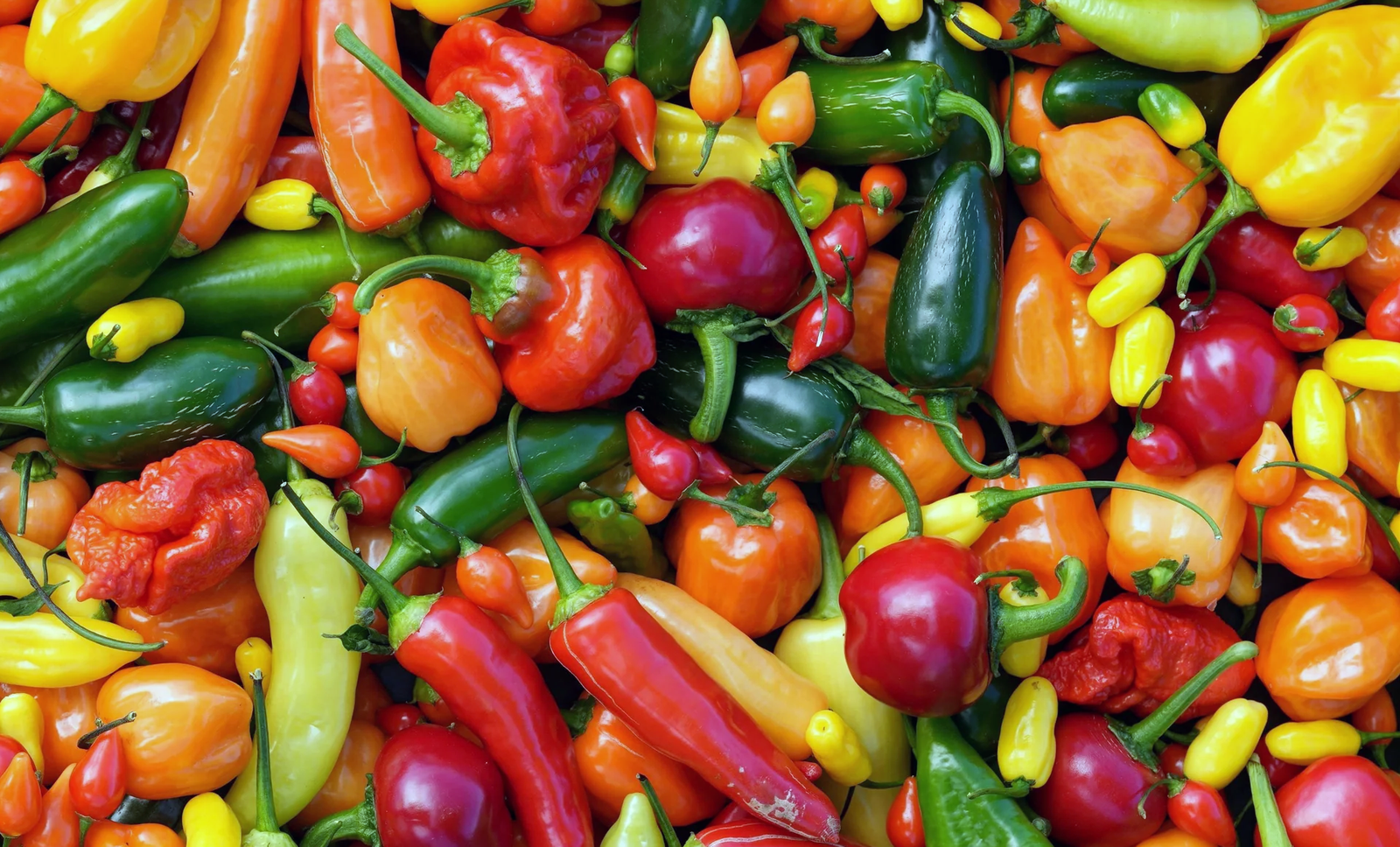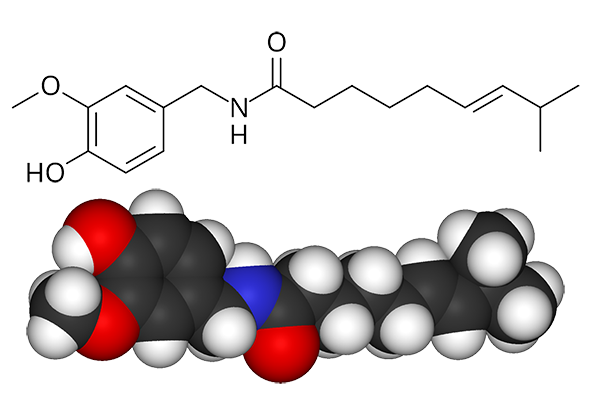FabulousFusionFood's Chilli-based Recipes 12th Page
 A mixture of different chilli peppers.
A mixture of different chilli peppers.
Welcome to FabulousFusionFood's Chilli-based Recipes Page — The recipes presented here all contain chilli peppers as a main ingredient. Chillies are the fruit of the chilli plant. Along with black pepper, they are unique spices in that they impart 'heat' to a dish without any associated bitterness. The dried and powdered fruit along with the fresh fruit and the dried fruit are all used as spices. As well as their capsaicin induced heat, chillies (depending on the variety or cultivar) can also imbue a dish with a fruity flavour. Smoked chillies are also used to impart a smokiness as well as heat to a dish.
Chilli peppers, also spelled chile or chili (from Classical Nahuatl chīlli [ˈt͡ʃiːlːi]) and known as hot peppers, are varieties of berry-fruit plants from the genus Capsicum, which are members of the nightshade family Solanaceae, cultivated for their pungency. Chilli peppers are widely used in many cuisines as a spice to add "heat" to dishes. Capsaicin and the related capsaicinoids give chillies their intensity when ingested or applied topically. Chilli peppers exhibit a range of heat and flavours. This diversity is the reason behind the availability of different types of chilli powder, each offering its own taste and heat level.
Chilli peppers originated in Central or South America and were first cultivated in Mexico. European explorers brought chillies back to the Old World in the late 16th century as part of the Columbian Exchange, which led to the cultivation of multiple varieties across the world for food and traditional medicine. Five Capsicum species have been widely cultivated: annuum, baccatum, chinense, frutescens, and pubescens.
 The capsaicin molecule, chemical structure (top) and space-filling model (bottom).
The capsaicin molecule, chemical structure (top) and space-filling model (bottom).
When peppers are consumed by mammals such as humans, capsaicin binds with pain receptors in the mouth and throat, potentially evoking pain via spinal relays to the brainstem and thalamus where heat and discomfort are perceived. However, birds are unable to perceive the hotness and so they can eat some of the hottest peppers. The intensity of the "heat" of chillies is commonly reported in Scoville heat units (SHU), invented by American pharmacist Wilbur Scoville in 1912. Historically, it was a measure of the dilution of an amount of chilli extract added to sugar syrup before its heat becomes undetectable to a panel of tasters; the more it has to be diluted to be undetectable, the more powerful the variety, and therefore the higher the rating. Since the 1980s, spice heat has been assessed quantitatively by high-performance liquid chromatography (HPLC), which measures the concentration of heat-producing capsaicinoids, typically with capsaicin content as the main measure
The alphabetical list of all the chilli-based on this site follows, (limited to 100 recipes per page). There are 1392 recipes in total:
Page 12 of 14
| Saint Lucia Papaya Hot Pepper Sauce Origin: Saint Lucia | Sarson ka Saag (Mustard Greens and Spinach Curry) Origin: India | Shito (Dark Chilli Sambal) Origin: Ghana |
| Saint Martin Poulet de Colombo Origin: Sint Maarten | Satan's Fantasy Chili Origin: American | Shitor Din Origin: Ghana |
| Saint Martin Poulet de Colombo Origin: Saint-Martin | Satay Origin: Indonesia | Shoko (Nigerian Beef and Spinach) Origin: Nigeria |
| Saint Martin Sauce Chien Origin: Saint-Martin | Satini Mangue Vert (Mauritian Mango Chutney) Origin: Mauritius | Si Byan (Burmese Fish Curry) Origin: Myanmar |
| Saint Vincent Green Seasoning Origin: Saint Vincent | Sattu Origin: India | Siboyo den pika (Onions in Hot Sauce) Origin: Bonaire |
| Saka saka (Congolese Cassava Leaves) Origin: Congo | Sauce Arachide de Burkina Faso (Burkinabe Peanut Sauce) Origin: Burkina Faso | Sierra Leonian Egusi Soup Origin: Sierra Leone |
| Saka-saka (Mutton and Cassava Leaf Stew) Origin: Guinea | Sauce aux Arachides (Guinean Peanut Sauce) Origin: Guinea | Sigá (Prawn and Okra Stew) Origin: Guinea-Bissau |
| Sakay Origin: Madagascar | Sauce Chien Origin: Saint Barthelemy | Silsi (Eritrean Tomato Sauce) Origin: Eritrea |
| Salade Chou Chou (Chako Salad) Origin: Mauritius | Sauce Chien Origin: Sint Maarten | Simple Mole Poblano Origin: Mexico |
| Salade de Zaalouk (Salad of Cooked Vegetables) Origin: Tunisia | Sauce d'Arachide (Beninese Peanut Sauce) Origin: Benin | Sing Mapan Singju (Ginger Flower and Water Dropwort Singju) Origin: India |
| Salata Aswad (Sudanese Aubergine Salad) Origin: Sudan | Sauce de Tomates Crues (Raw Tomato Sauce) Origin: Benin | Sint Maarten Crab Backs Origin: Sint Maarten |
| Salata Méchouia Nablia (Grilled Red Pepper, Chilli and Tomato Salad) Origin: Tunisia | Sauce Gbanbouda (Tô with Okra Sauce and Peanuts) Origin: Guinea | Sint Maarten Roe Accras Origin: Sint Maarten |
| Salmi Poulet Mauriticien (Chicken Mauritius) Origin: Mauritius | Sauce Gombo (Gombo Sauce) Origin: Guinea | Sint Maarten Stewed Saltfish Origin: Saint-Martin |
| Salmon Kalia in Panch Phoron Sauce Origin: India | Sauce Gombo et Boeuf (Okra Sauce with Beef) Origin: Burkina Faso | Slow Cooker Chicken Korma Origin: Britain |
| Salmon with Acacia Seed and Tasmanian Pepper Berry Rub Origin: Australia | Sauce Gombo Togolaise (Togolese Okra Sauce) Origin: Togo | Slow-roast Lamb Shoulder with Honey, Herbs and Harissa Origin: Britain |
| Salsa con Queso Jalapeña (Nicaraguan Cream Sauce with Cheese) Origin: Nicaragua | Sauce Gombos Burkinabé (Burkinabe Okra Sauce) Origin: Burkina Faso | Smoked Chillies Origin: Mexico |
| Salsa de Abacate de Guineano (Equatorial Guinean Avocado Salsa) Origin: Equatorial Guinea | Sauce Légume Origin: Benin | Smoked Fish Light Soup Origin: Ghana |
| Salsa de Chile Rojo (Red Chilli Sauce) Origin: Spain | Sauce piquante créole (Creole Hot Sauce) Origin: Guadeloupe | Smoky Prawn Jollof Rice Origin: Nigeria |
| Salsa Jalapeña (Nicaraguan Cream Sauce) Origin: Nicaragua | Sauci Yohss (Gambian Mussel Meats in Tomato Sauce with Potatoes) Origin: Gambia | Sofrito Origin: Spain |
| Salt Cod Fish Cakes Origin: Bahamas | Scallop and Prawn Chu Chee Origin: Thailand | Sofrito Cubano (Cuban Sofrito) Origin: Cuba |
| Saltfish Accra Origin: Barbados | Scotch Bonnet Hot Sauce Origin: Jamaica | Sokossoko de Rognon (Sokossoko with Kidneys) Origin: Burkina Faso |
| Saltfish Salad Origin: Anguilla | Seafood Chili Origin: American | Solachi Kadhi (Kokam Sauce) Origin: India |
| Samaki wa Kakuango (Fried Fish with Onions) Origin: Tanzania | Seaweed Vinegar Origin: Canada | Solomon-a-Gundy Origin: Jamaica |
| Samaki wa Kapaka (Zanzibar Grilled Fish) Origin: Tanzania | Seengre ke Satha Tori Kari (Courgette Curry with Radish Pods) Origin: India | Somlar Mochu Sachko (Sour Beef Stew) Origin: Cambodia |
| Sambal Belacan Origin: Malaysia | Seitan Nyembwe Origin: African Fusion | Sopa Mexicana de Flor de Calabaza (Mexican Pumpkin Flower Soup) Origin: Mexico |
| Sambal Olek Origin: Indonesia | Senegalese Vegetable Stew with Millet Origin: Senegal | Sopi di Piská (Fish Soup) Origin: Aruba |
| Sambal Telur Origin: Malaysia | Serekunda Fish Benachin Origin: Gambia | Sopi di Piská (Fish Soup) Origin: Bonaire |
| Sambal Tomat (Tomato Sambal) Origin: Aruba | Shakshooka (Egg and Chilli Breakfast) Origin: Libya | Sopi di Piská (Fish Soup) Origin: Curacao |
| Sambhar Masala Origin: India | Shami Kebab Origin: India | Sorpotel Origin: India |
| Samlar Machu (Cambodian Sour Soup) Origin: Cambodia | Shata Origin: Sudan-a | Sos Ti-malice (Ti-malice Sauce) Origin: Haiti |
| Samusa aux Crevettes Réunionaise (Reunion Shrimp Samosas) Origin: Reunion | Sherry Pepper Sauce Origin: Bermuda | Soup Joumou (Haitian Squash Soup) Origin: Haiti |
| Sancoche Origin: Trinidad | Shigni (Somali Hot Sauce) Origin: Somalia | Soupa Canja (Okra and Palm Oil Soup) Origin: Gambia |
| Sancochi di Galinja (Chicken Stew) Origin: Aruba | Shin Ngoa Lap (Spicy Beef Salad) Origin: Laos | |
| Sanger Yena (Offal Sausages) Origin: Aruba | Shish Kebabs Origin: Britain |
Page 12 of 14